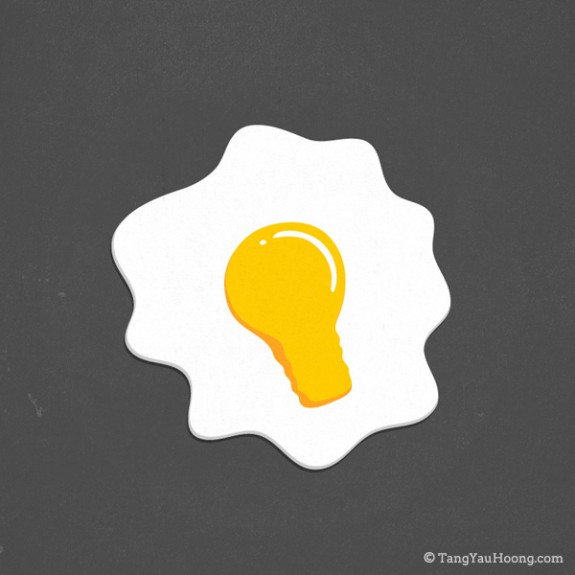As many of you know, I’ve been on a major reading kick, consuming as many books about creativity and entrepreneurship as I can find. So, when a colleague sent me a copy of Idea Stormers: How to Lead and Inspire Creative Breakthroughs by Bryan Mattimore a few weeks ago, it didn’t take long to get me hooked on this book. This week I’m very excited to have Bryan Mattimore joining us for a two-part Q&A, answering questions about his book, his creative process, and–most importantly–how writers can apply these techniques to their own work.
Can you tell us a little about the concept behind Idea Stormers and what led you to write this book?
My life’s work has been to understand and invent new creative processes, both for individuals and teams. Because my Growth Engine coworkers and I consult primarily with businesses, and more specifically business teams, our creative work has had to be very bottom line-oriented. Every day we’re being judged on how well we’ve helped our clients generate that next big, breakthrough idea. And even though we’re always experimenting and inventing new creative techniques–which makes our work enormously fun–we also know that at the end of the day whatever idea-generation processes we use, they have to deliver. A great deal of trial and error in several thousand ideation sessions and creative focus groups has helped us understand which creative techniques have the greatest likelihood of success for a particular kind of creative challenge. I wrote Idea Stormers because I wanted to share what we’ve learned and potentially multiply the impact of our work. We all know one great idea can change the world. The processes in Idea Stormers can help individuals and teams generate a great many new ideas.
Could you clarify a term for us? What is ideation exactly and how is it different from brainstorming?
Brainstorming is actually a specific group creative technique invented in the 1930’s, even though it’s commonly used as a generic term to represent the process of coming up with a new idea. The two basic tenants of the brainstorming technique are: 1) to get a few good ideas generate a lot of ideas, and 2) don’t judge others ideas while you’re generating ideas since if you do, it will shut down the creative process.
Since the 1930’s, tremendous advancements have been made in the number and kinds of creative techniques to help individuals and groups generate new ideas. So a new term “ideation,” evolved to represent these newly-invented creative approaches, processes and techniques. And yes, you will find the terms “ideation” and “ideating” in the Scrabble dictionary.
Idea Stormers focuses on the ideation process in the business environment, but many of the same creative challenges can also apply to writers. After all these days authors aren’t just writers, they also have to be entrepreneurs, marketers… in some cases even their own publishers. How might a writer apply some of the business ideation techniques you discuss in the book?
If, as a writer, you look at your book as a product, which of course it is, there should be much of interest in Idea Stormers. Replace the words “new product” with “book,” and you’ll discover that there are dozens of “book marketing” idea-generation techniques in Idea Stormers. Some of these techniques include picture prompts, day-in-the-life, worst idea, target market wishing, magazine rip and rap, and You Tube video prompts, etc.
A trick that writers can use–both to add dimension to characters and story ideas, as well as to title or position a book–is to “get visual.” Getting visual can be particularly valuable when the finite nature of words seems to be imposing limits on the infinite possibilities of the imaginative mind.
Looking to write better descriptions of the physical features of your lead character? Search online visual databases to inspire you. Want a better feel for the psychology of a particular character? Create a collage of his or her most intimate desires and wishes. Not quite sure how to describe a particular location in a unique and compelling way? Watch movie clips or You Tube videos.
As you know, there are also some creative challenges unique to writers. How might the ideation process for a writer differ from that someone in the business environment and how can writers use the techniques in your book?
There’s a surprisingly productive technique we use in our ideation sessions we call The Worst Idea technique. Instead of trying to generate good ideas, the teams first create terrible, awful, stupid, ridiculous, absurd, gross, crazy, even sexually-inappropriate ideas. Bad, really bad ideas. Then teams use these worst ideas to trigger good ideas: by either thinking of the opposite of the worst idea, or by thinking that as bad as is this worst idea is, there is something in it they can use to inspire a good idea.
One of the challenges of good writing is to continually surprise the reader; but only in ways that are consistent with the characters, the situation, and the narrative. Sometimes (much as when using the worst idea to generate a good idea) it’s as simple as doing the exact opposite of what is expected or “obvious.” For instance, in the movie Terms of Endearment, we expect Garrett Breedlove (Jack Nicholson), the philandering ex-astronaut, to be the aggressor in the lovemaking scene with his next-door neighbor, Aurora (Shirley MacLaine). But in an hilarious reversal of the expected, it is the feisty Aurora who takes control!
When you’re in need of outside inspiration, where do you turn? Also do you have a creative ritual that helps get you in “the zone”?
I go to a lot of movies, and I “theme read” books. For instance, I am now writing a young adult novel that uses the creative process as its theme. So, I ordered a dozen different creative-thinking puzzle books to help inspire me and sensitize me to the creative problem solving challenges that kids in junior high and high school are asked to solve.
I’m also “theme reading” 1984, Utopia, Walden Two, and Brave New World because I’ve become interested in how societies can be re-imagined to help individuals within that society realize more of their creative potential.
To get in the zone, I will tell you several things I don’t do! I’m not inspired by the smell of rotten apples (as was true of German poet and philosopher Friedrich Schiller), or by drinking over 50 cups of coffee a day (as Balzac did), or even by writing standing up (as Hemingway did) or writing lying down (as Mark Twain sometimes did). No, I get into the zone by playing tricks on myself. One trick I use is to work on the easily achievable first: something I know I can succeed with as a prelude to tackling a really tough writing challenge. I’m thinking now specifically of the rewrites I had to do on Idea Stormers. Some of the creative challenges from my two editors were to be more explicit about teaching moments, and be even clearer about how people new to the field might apply a specific creative technique. As an expert in the field of group ideation and organizational innovation, it meant I would often take things for granted. Being explicit about how or why something will work (when it was so obvious to me because of my experience) made for some difficult writing challenges.
This path of least resistance–saving some of the harder creative challenges for later– enables me to build on success by completing the easier re-writes first. But it also allows the creative subconscious the “soak time” it needs to work the problem; and which in time will, as Norman Lear one said, “slip me a note, like in study hall, with the answer.”
Any other words of advice to writers who want to boost their creativity?
If I hadn’t signed the contract to write Idea Stormers it would not be on the market now or possibly even years from now. I intentionally created the conditions that forced me into having two jobs for the five months it took me to write, and re-write, the book. I had my “day job” of running my company and doing client work; and the late night, early morning, vacation, and weekend job of writing the book. I had committed to writing a 60,000 word book and so when I did the math, I knew that I’d have to write 500 words a day. I didn’t have a choice. So deadlines have a funny way of boosting creativity.
One of the big surprises of the Idea Stormers launch is that I’m now having to write as much, or even more now than when I was writing the book. My PR firm has gotten me opportunities to write guest blogs, Q & A’s, and magazine articles for CNBC, Fast Company, Forbes, etc. I thought I could re-package the material I had already written, but in most cases I have to create original works – as I’m doing now with this Q&A for DIYMFA.
So my last words of advice to writers are: create conditions to force yourself to write more, especially if you’re like me, someone who would prefer to watch the Giants game than write.
Want to learn more about how to boost your creativity? Stay tuned for part two of the Q&A with Bryan tomorrow. You’ll get an inside look at how you can apply specific techniques from his book to different aspects of your writing.

 Bryan Mattimore is one of America’s top experts in applied creativity, ideation facilitation and innovation management. His bestselling book, 99% Inspiration: A Real World Guide to Business Creativity was selected as the American Management Association’s membership book of the year. His articles on applied creativity have appeared in dozens of magazines including Advertising Age, Reader’s Digest, The Futurist, Omni and Success. He has successfully facilitated more than 1,500 business and marketing ideation sessions for clients, including Sony, DKNY, Wyeth, Unilever, IBM, Honeywell, Pepsi, Centrum, Dove, Crayola, Bauer, Ford, the City of New York, and Craftsman.
Bryan Mattimore is one of America’s top experts in applied creativity, ideation facilitation and innovation management. His bestselling book, 99% Inspiration: A Real World Guide to Business Creativity was selected as the American Management Association’s membership book of the year. His articles on applied creativity have appeared in dozens of magazines including Advertising Age, Reader’s Digest, The Futurist, Omni and Success. He has successfully facilitated more than 1,500 business and marketing ideation sessions for clients, including Sony, DKNY, Wyeth, Unilever, IBM, Honeywell, Pepsi, Centrum, Dove, Crayola, Bauer, Ford, the City of New York, and Craftsman.







